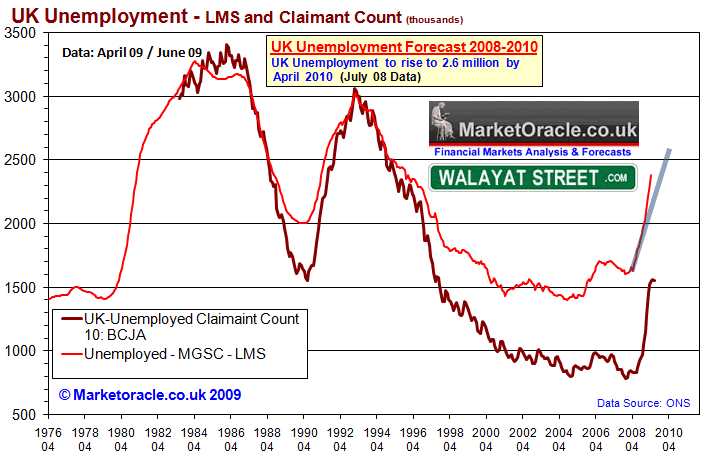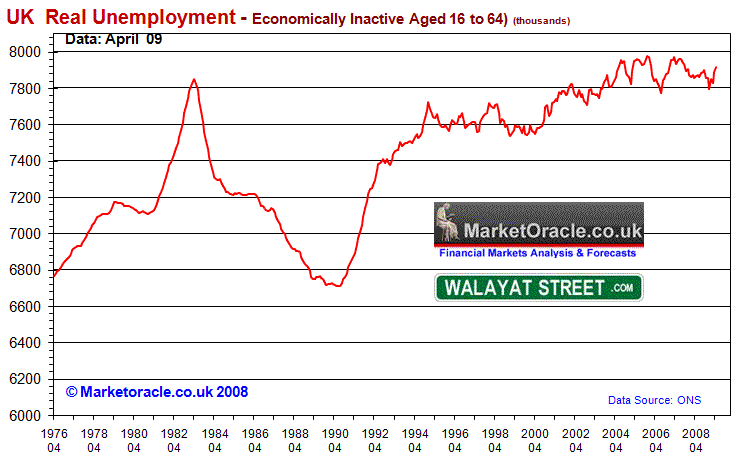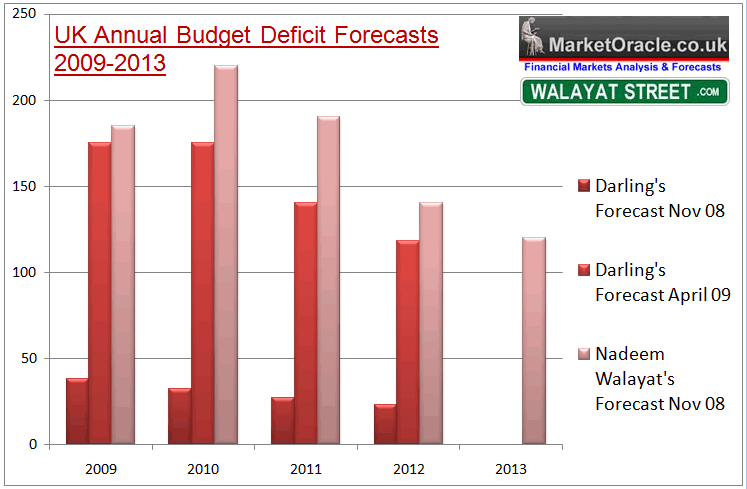UK Unemployment Record Rise, a Jobless Debt Fuelled Economic Recovery?
Economics / Recession 2008 - 2010 Jul 15, 2009 - 06:23 PM GMTBy: Nadeem_Walayat
 UK headline Unemployment rate (ILO) surged higher by a near unprecedented number of 281,000 in the three months to the end of April 09, taking unemployment to a 13 year high of 2.38 million to officially stand at 7.6% of the workforce. Meanwhile the job seekers benefit claimant count rose by 30,000 to the quarter to the end of June to stand at 1.553 million. The surge in unemployment has been widely carried by the tv news media and mainstream press to imply a very weak jobless recover that suggests unemployment levels to rise significantly about 3 million by early next year.
UK headline Unemployment rate (ILO) surged higher by a near unprecedented number of 281,000 in the three months to the end of April 09, taking unemployment to a 13 year high of 2.38 million to officially stand at 7.6% of the workforce. Meanwhile the job seekers benefit claimant count rose by 30,000 to the quarter to the end of June to stand at 1.553 million. The surge in unemployment has been widely carried by the tv news media and mainstream press to imply a very weak jobless recover that suggests unemployment levels to rise significantly about 3 million by early next year.
UK Unemployment Forecast and Trend
The original forecast of October 2008 (July 08 data) as illustrated by the below graph, forecast UK unemployment to hit 2.6 million by April 2010. The trend to date of 2.38 million to April 2009 clearly continues to suggest a much higher peak which remains on track to hit 3 million, as unemployment tends to lag economic recoveries by anywhere from between 6 to 12 months.
However on a slightly more positive note, the most recent claimant count monthly data showed a dip in the June data to 1.553 million from 1.565 million therefore suggesting that the momentum of rising unemployment as a consequence of the the first quarter economic crash is beginning to dissipate and stabilise towards a far more shallower trend in rising UK unemployment, though this can be partially explained away by government interventions such as the New Deal which take people off of the official claimant count and place them under other 'headings', thus masking the true number claiming what are still in effect unemployment benefits.
Meanwhile the number of vacancies continues to dry up by hitting a record low of 421,000 in June 2009 which is suggestive of a jobless recovery.

Whilst the mainstream press focus has been on the headline unemployment data and the benefits claimant count, however the real number of unemployed stands far higher when taking into account all those of working age (16 to 64) as illustrated below with the total at 7.915 million, which is reflective of a contracting labour market with net outward migration as primarily eastern european workers are apparently returning home in the face of increasing difficulties in the UK labour market.

UK Unemployment Time bomb
The potential spanner in the works for a stabilising labour market was illustrated in my analysis of 21st February 09 ( UK Unemployment Time Bomb to Explode July 2009) warned that there exists the unemployment time bomb of the estimated 600,000 of school, college,leavers and graduates that are expected to join the labour market in July 2009 which could result in a surge of unemployment of as many as 250,000 in a single month, with also extra high unemployed numbers for subsequent months, this factor is now also starting to be recognised by the mainstream press that is suggesting that as many as half of the 600,000 graduates will not be able to find work and thus many of whom will be come unemployed. Therefore July and August unemployment data may produce surprises to the upside after more subdued May and June data.
Youth unemployment now stands at more than 1 million with 17.3% of those aged 17 to 24 unemployed, which carries the serious risk of of a lost generation much as occurred during the mid 1980's, as the growing debt mountain ensures deep public spending cuts and tax rises following the May 2010 general election which is projected to further add to a stagnant labour market with an persistent unemployed number north of 3 million.
Sectors Hit by Unemployment
As expected the sectors most hit by the recession over the last 12 months having recorded job losses have been in Finance down 187,000; manufacturing down 212,000 and retail down 196,000. Meanwhile offsetting this has been the surge in public sector jobs of 168,000. However the analysis Bankrupt Britain's Public Sector Double Dip Debt Recession on Deep Spending Cuts warned of deep spending cuts that would signal a public sector double dip recession that would soon follow the May 2010 General Election, this also sets the scene for areas of the country that are heavily reliant on public sector such as the North East, North West and Wales to experience a much deeper second recession.
Unemployment Benefits Contributing to Huge Budget Deficits
As the the employed become unemployed, tax revenues turn into benefits payments thus contributing towards a widening in the gap between the governments revenue and expenditure that continues to grow despite the debt fuelled economic recovery into a May 2010 election. This is expected to contribute towards a £20 billion shortfall during 2009 due to the increase in unemployment from 2 million to 3 million by year end.

The debt mountain has exploded to more than 12% of GDP for 2009 and expected to continue at levels of above 10% of GDP for at least the next 5 years regardless of spending cuts after the next election. The growing debt mountain will result in a prolonged period of above average inflation and interest rates as the market will demand higher interest rates to finance the extra government debt resulting in higher inflation as the government is forced to devalue the debt mountain by means of inflation to finance the higher interest payments with the most probable outcome of a second more severe double dip recession during 2011-2012.
Government bonds have already reacted by a steeping of the yield curve on the back of a strengthening economy and higher inflation expectations despite this weeks report of RPI deflation hitting -1.6%.
Conclusion - UK Unemployment remains on track to trend higher towards 3 million by the end of 2009, boosted by some 250,000 school, college and University leavers unable to find work. This gives the government the green light for further economic stimulus (debt) into the May 2010 general election as well as for the Bank of England to escalate its quantitative easing / money printing programme beyond the £125 billion to date.
By Nadeem Walayat
http://www.marketoracle.co.uk
Copyright © 2005-09 Marketoracle.co.uk (Market Oracle Ltd). All rights reserved.
Nadeem Walayat has over 20 years experience of trading derivatives, portfolio management and analysing the financial markets, including one of few who both anticipated and Beat the 1987 Crash. Nadeem's forward looking analysis specialises on the housing market and interest rates. Nadeem is the Editor of The Market Oracle, a FREE Daily Financial Markets Analysis & Forecasting online publication. We present in-depth analysis from over 250 experienced analysts on a range of views of the probable direction of the financial markets. Thus enabling our readers to arrive at an informed opinion on future market direction. http://www.marketoracle.co.uk
Disclaimer: The above is a matter of opinion provided for general information purposes only and is not intended as investment advice. Information and analysis above are derived from sources and utilising methods believed to be reliable, but we cannot accept responsibility for any trading losses you may incur as a result of this analysis. Individuals should consult with their personal financial advisors before engaging in any trading activities.
Nadeem Walayat Archive |
© 2005-2022 http://www.MarketOracle.co.uk - The Market Oracle is a FREE Daily Financial Markets Analysis & Forecasting online publication.



